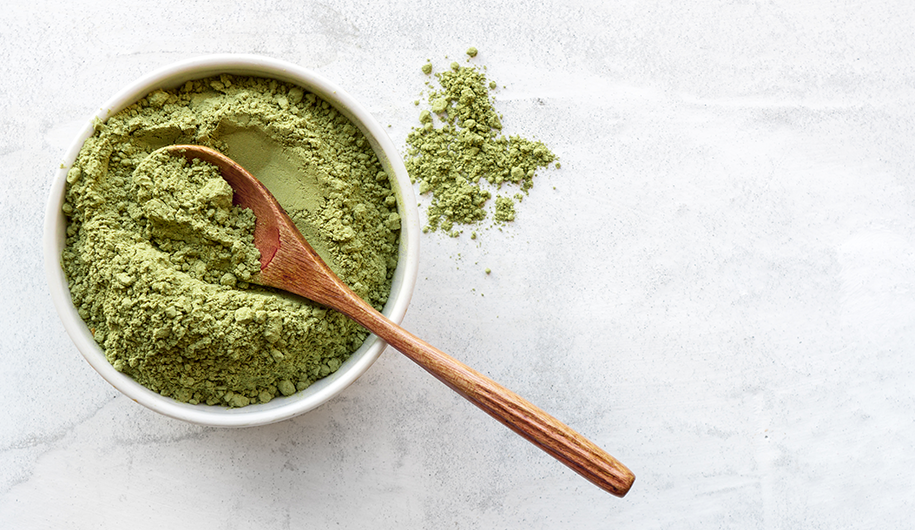
What’s the deal with matcha powder? You’ve seen it all over Instagram, those matcha lattes that all the cool urban cafes have now, the doughnuts, the ice cream… But there’s nothing new here really - people have been taking matcha for centuries, find out why below.
What is matcha powder?
Matcha powder, what is it? The literal translation is ‘powered tea’, so it’s the entire leaf! That’s why it’s even more awesome than other green teas. Unlike traditional green tea, matcha tea leaves are shaded from the sun before they’re harvested. This increases the chlorophyll content which gives matcha a vibrant green colour. The taste is best described as strong and vegetal, perhaps even spinachy.
Matcha tea leaves are hand selected and steamed briefly to stop fermentation. The next stage is to then dry and age the leaves in cold storage - which deepens the flavour. Dried leaves are then stone-ground into a fine matcha powder.
Unlike most brewed teas, where you steep the leaves and then chuck them, matcha is the whole leaf. When you digest the entire leaf, you’re getting all of the polyphenols and the health benefits - which we’ll get into now.
1. Matcha powder is high in antioxidants
Just one cup of matcha has an off the chart ORAC score, providing you with loads more antioxidants than even goji berries or raw chocolate! Get the best of both worlds, and make this Matcha Chocolate Torte. This recipe is by the talented Olivia Scott of The Raw Kitchen and is featured in our FREE ebook, get your copy here.
ORAC (Oxygen Radical Absorbance Capacity) is a method of measuring antioxidant capacity. So, the higher the ORAC value, the greater the antioxidant powers. Matcha has an ORAC value of 168,500/100g, so to put this in perspective, acai berries have an ORAC value of 102,700.
2. Matcha is clinically proven to protect cells from DNA damage
We already know matcha is high in antioxidants, but matcha also contains a super antioxidant called catechin. Matcha’s most powerful catechin is a called called epigallocatechin gallate (EGCG), which is thought to be anti-carcinogenic.
EGCG has super free radical scavenging abilities and have been clinically proven to protect cells from DNA damage caused by reactive oxygen species.
A 2003 University of Colorado study confirmed that drinking 1 cup of matcha green tea has 137 times the amount of antioxidant EGCG compared to a conventional cup of green tea.
3. Matcha is possibly detoxifying
Matcha is grown in the shade, which is why it is richer in chlorophyll - the pigment responsible for matcha's bright green, Hulk like appearance. That's why matcha is greener that all the other green teas.
Although yet to be scientifically prove, chlorophyll is thought to detoxify the body. Hence, it is thought that matcha can help the body purge toxins, heavy metals and hormone disrupters.
4. Matcha reduces bad cholesterol levels
A 2011 study in the American Journal of Clinical Nutrition found that green tea beverages or extracts resulted in significant reductions in LDL cholesterol and triglyceride levels. LDL is the bad cholesterol that causes cardiovascular disease.
5. Matcha powder is Energising
Yes matcha powder does contain caffeine but 1 gram of matcha contains only about 25 mg to 30 mg of caffeine versus a shot off coffee which would have anywhere between 80 to 100 mg of caffeine.
Before we mentioned that the leaves are shaded before harvesting, well this also increases the content of L-Theanine, an amino acid that helps balance caffeine. So while matcha contains caffeine like other teas, the L-Theanine is known to create a calming effect, the opposite of caffeine’s effect. Plus, matcha shots are so hot right now! Models were sipping on them backstage at New York Fashion Week.
6. Matcha can help you burn fat
Not joking, a 1999 study in the American Journal of Clinical Nutrition found that matcha green tea extracts rich in catechins has thermogenic properties that promotes fat oxidation.
Other studies have also found that matcha can increase resting metabolic rate, helping the body burn more fat. Another study found that people who hit the gym straight after drinking matcha green tea burned 25% more fat during their workout.
This study back in 2005 found that daily consumption of matcha green tea containing 690 mg of catechins, for twelve weeks, reduced their body weight! Of course you need to eat well too, you can’t expect to live off matcha and pizza and lose weight!
So how much do you need to consume really? Well one gram of matcha powder contains 105 mg of catechins, a serve is about 5 grams, so just over a teaspoon is all!
Matcha is available as a concentrated powder, and even though it might cost a bit more than other green teas, you don’t need as much to get all the benefits. Some studies reckon that as little as 1 teaspoon of matcha is the same as drinking up to 10 cups of other green tea.
Where and how to buy matcha powder
Organic versus non-organic? The difference like all certified organic foods is that an organic matcha powder (like ours) has been grown without any chemical fertilisers, herbicides or pesticides. By choosing certified organic foods, that's not only a win for your health and wellbeing, but a win for the environment.
You'll find organic matcha powder available at most health food stores.







